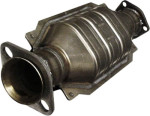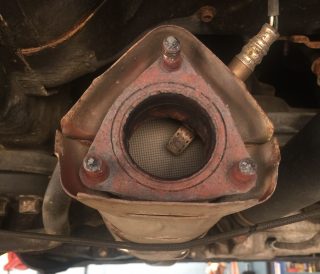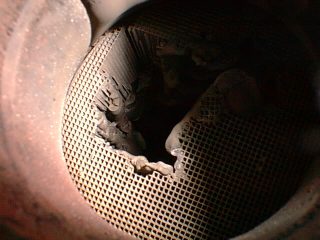 We all want to make sure we’re doing our part to reduce our impact on the environment. A big part of that is making sure your vehicle is in tip-top shape, minimizing harmful exhaust emissions. That’s why, in Maryland, we’re all required to have our vehicle’s emissions systems inspected every two years to make sure it’s functioning properly.
We all want to make sure we’re doing our part to reduce our impact on the environment. A big part of that is making sure your vehicle is in tip-top shape, minimizing harmful exhaust emissions. That’s why, in Maryland, we’re all required to have our vehicle’s emissions systems inspected every two years to make sure it’s functioning properly.

Looking into a properly working catalytic converter from the rear. You can see the “honeycomb” substrate. You also can see the oxygen sensor that tells the vehicle’s on-board computer how well the catalyst is working.
A major portion of your emissions control system is the catalytic converter. It’s part of the exhaust system and contains a ceramic honeycomb called a substrate. That substrate has precious metals like platinum, palladium, rhodium and cerium embedded in it. Hot exhaust gasses pass through the substrate and the elements act as a catalyst, causing a chemical reaction in the gasses. That reaction changes the chemical makeup of the exhaust and results in cleaner emissions and, of course, a cleaner environment.
Now, it’s important to keep your engine running properly. Misfires can cause the material inside the catalytic converter to overheat, causing the substrate to melt or break into pieces. Catalytic converters are inherently expensive to replace, given the precious metals in it. If your vehicle isn’t running right or if your check engine light is flashing, give us a call right away!

Looking into a failed catalytic converter. You can see a large portion of the substrate material has melted away.
Here at Motor Works, we routinely perform complete emission systems diagnosis and repair. We also partner with the Montgomery County Department of Environmental Protection.
